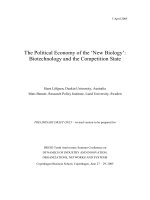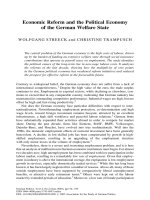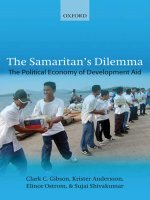Slide global business today chap005 the political economy of international trade
Bạn đang xem bản rút gọn của tài liệu. Xem và tải ngay bản đầy đủ của tài liệu tại đây (103.42 KB, 19 trang )
McGraw-Hill/Irwin
© 2004 The McGraw-Hill Companies, Inc., All Rights
CHAPTER
5
The Political Economy of
International Trade
McGraw-Hill/Irwin
© 2004 The McGraw-Hill Companies, Inc., All Rights
Key Issues
• How do governments use policy to restrict imports
and promote exports?
• Why do some governments intervene to influence
import-export flows?
• Is such government intervention self-defeating?
• What is the evolution, purpose of the global
trading system (GATT, WTO)?
• What are the implications on business of
government intervention?
McGraw-Hill/Irwin
© 2004 The McGraw-Hill Companies, Inc., All Rights
Slide
5-1
Governments and Trade
• Free trade: a government does not restrict what its
citizens can but from or sell to another country
• Smith, Ricardo, Heckscher-Ohlin: free trade
enhances economy
• Higher level domestic consumption; more
efficient use of resources
• Stimulation of domestic growth and wealth
creation
McGraw-Hill/Irwin
© 2004 The McGraw-Hill Companies, Inc., All Rights
Slide
5-2
Governments and Trade
• More often governments manage trade
(… level the “playing-field”)
– Restriction of imports: protectionist intervention
– Promotion of exports
– Trade promo and FDI incentives
• Free-trade “Good” or “Bad”?
– Social issues related to free-trade
– Implications for business and individual groups
McGraw-Hill/Irwin
© 2004 The McGraw-Hill Companies, Inc., All Rights
Slide
5-3
Instruments of Trade Policy
•
•
•
•
•
•
•
McGraw-Hill/Irwin
Tariffs
Subsidies
Import quotas
Voluntary export restraints
Local content requirements
Anti-dumping policies
Administrative policies
© 2004 The McGraw-Hill Companies, Inc., All Rights
Slide
5-4
Tariffs
• Taxes levied on imports (also sometimes on exports)
– Specific tariff: fixed charge for each good imported
– Ad valorem tariff: a % of imported goods value
• Who gains:
– Government
– Domestic producers (at least in the short run)
– Employees of protected industries keep their jobs
• Who loses:
– Consumers who pay higher prices
– The economy which remains inefficient
– Employees of protected industries who don’t develop
new skills
McGraw-Hill/Irwin
© 2004 The McGraw-Hill Companies, Inc., All Rights
Slide
5-5
Subsidies
• Are government payments to domestic producers
– Cash grants, low-interest loans, tax breaks, government
equity participation in domestic firms, government
orders
• Subsidies are aimed at lower costs to help
–
–
–
–
Compete against cheaper imports
Gain export markets
Increase domestic employment
Local producers achieve first-mover advantage in
emerging industries
• Governments tax individuals… to pay for subsidies
• Consumers buy more expensive goods with lower
disposable incomes
McGraw-Hill/Irwin
© 2004 The McGraw-Hill Companies, Inc., All Rights
Slide
5-6
• Import Quotas and Voluntary Export
Restraints
– Import quota: government specifies how much of
what product can be imported from which countries
– Voluntary export restraint: a quota imposed by the
exporting country officially or unofficially
• Local Content Requirements
– Some % of a good has to be produced domestically
with local raw materials and local labor
– Used by LDCs to
• Achieve technology transfer, skills transfer
• Shift manufacturing base to a higher technological level
– Similar effects to those of import quotas
McGraw-Hill/Irwin
© 2004 The McGraw-Hill Companies, Inc., All Rights
Slide
5-7
• Anti-dumping Policies
– Dumping: selling goods in an overseas market
• At below their production costs or
• Below “fair market value”
– Anti-dumping policies punish producers who dump
and protect domestic producers
• Administrative policies
– Bureaucratic rules that make it difficult for imports
to enter a country
McGraw-Hill/Irwin
© 2004 The McGraw-Hill Companies, Inc., All Rights
Slide
5-8
Political Arguments for Intervention
•
•
•
•
•
National security
Individual industries and jobs protected
Retaliation
Consumer protection (health, safety)
Furthering foreign policy objectives
Economic Arguments for Intervention
• Infant industry protection
• Strategic trade policy
McGraw-Hill/Irwin
© 2004 The McGraw-Hill Companies, Inc., All Rights
Slide
5-9
International Trade Cooperation (!)
• U.S.A. and:
– foreign companies trading with Cuba
– any company dealing with Iran-Iraq
• W.T.O. in place but...
– disputes with China dealt on bilateral basis
– disputes with Japan dealt on bilateral basis
– trade blocks proliferating
McGraw-Hill/Irwin
© 2004 The McGraw-Hill Companies, Inc., All Rights
Slide
5-10
The Global Trading System
• Smith to Great Depression
– Britain adopts free trade in 1846
– Smoot-Hawley act (US) 1930 aimed at employment
protection one cause of the Great Depression
• 1947-1979: GATT, Trade Liberalization,
Economic Growth
• 1980-1993: GATT needs fixing
– Uruguay round of GATT negotiations (1986-1993)
– Creation of WTO with powers to implement trade
agreements
McGraw-Hill/Irwin
© 2004 The McGraw-Hill Companies, Inc., All Rights
Slide
5-11
GATT
• Pre-WWII protectionism
– Smoot-Hawley +57% import tariffs (1930)
– UK, France, Italy followed suit
– world depression in ‘30s
• Havana Conference (1947) -> GATT
–
–
–
–
125 countries by 1994
small staff in Geneva
tariffs fm 40% in ‘47 to 3% in ‘95
trade 15x to $6.75 trillion in ‘92
• WTO superceded GATT in 1995
McGraw-Hill/Irwin
© 2004 The McGraw-Hill Companies, Inc., All Rights
Slide
5-12
GATT/WTO
• MFN-Most Favored Nation
– any preferential treatment offered to one member
country must be extended to all other members
– members can extend MFN to non-members
• Exceptions
– GSP (Generalized System of Preferences) for
LDCs
– regional arrangements such as NAFTA
– countries still use NTBs, other loopholes (peanut
waiver, 1955)
McGraw-Hill/Irwin
© 2004 The McGraw-Hill Companies, Inc., All Rights
Slide
5-13
Uruguay Round of GATT negotiations
• Tariffs cut further
• Agricultural Policy Modified:
– cut price supports 20%, export subsidies 36%
– For this policy: USA, Argentina, Australia, Canada
– Anti: Japan, Korea, India, EU
• Services given prominence: developed set of principles
• Intellectual Property Rights protected further: patents,
copyrights, trademarks, brand names
• WTO created: to implement Uruguay round, controversial
McGraw-Hill/Irwin
© 2004 The McGraw-Hill Companies, Inc., All Rights
Slide
5-14
WTO: Early Experience
• WTO as a global policeman
– Up to 1995-1999: 160 ± cases brought for decision
– 30 ± withdrawn after direct discussions between
countries in dispute
– 100 + undergoing direct discussion
– 20 ± in final stage of solution implementation
– 4 have been settled
– 7 closed with no need for action
• GATT dealt with 196 cases from 1947-1995!
• WTO telecommunications agreement 1998 (effect)
• WTO Financial Services agreement 1999 (effect)
McGraw-Hill/Irwin
© 2004 The McGraw-Hill Companies, Inc., All Rights
The Future of WTO
•
•
•
•
Antidumping Action
Protectionism in Agriculture
Protecting Intellectual Property
Launching a new round of talks: Doha
McGraw-Hill/Irwin
© 2004 The McGraw-Hill Companies, Inc., All Rights
Slide
5-15
“So what” for Business”
• Trade barriers affect firm strategy
• Government policy has direct impact on
firm business
McGraw-Hill/Irwin
© 2004 The McGraw-Hill Companies, Inc., All Rights









